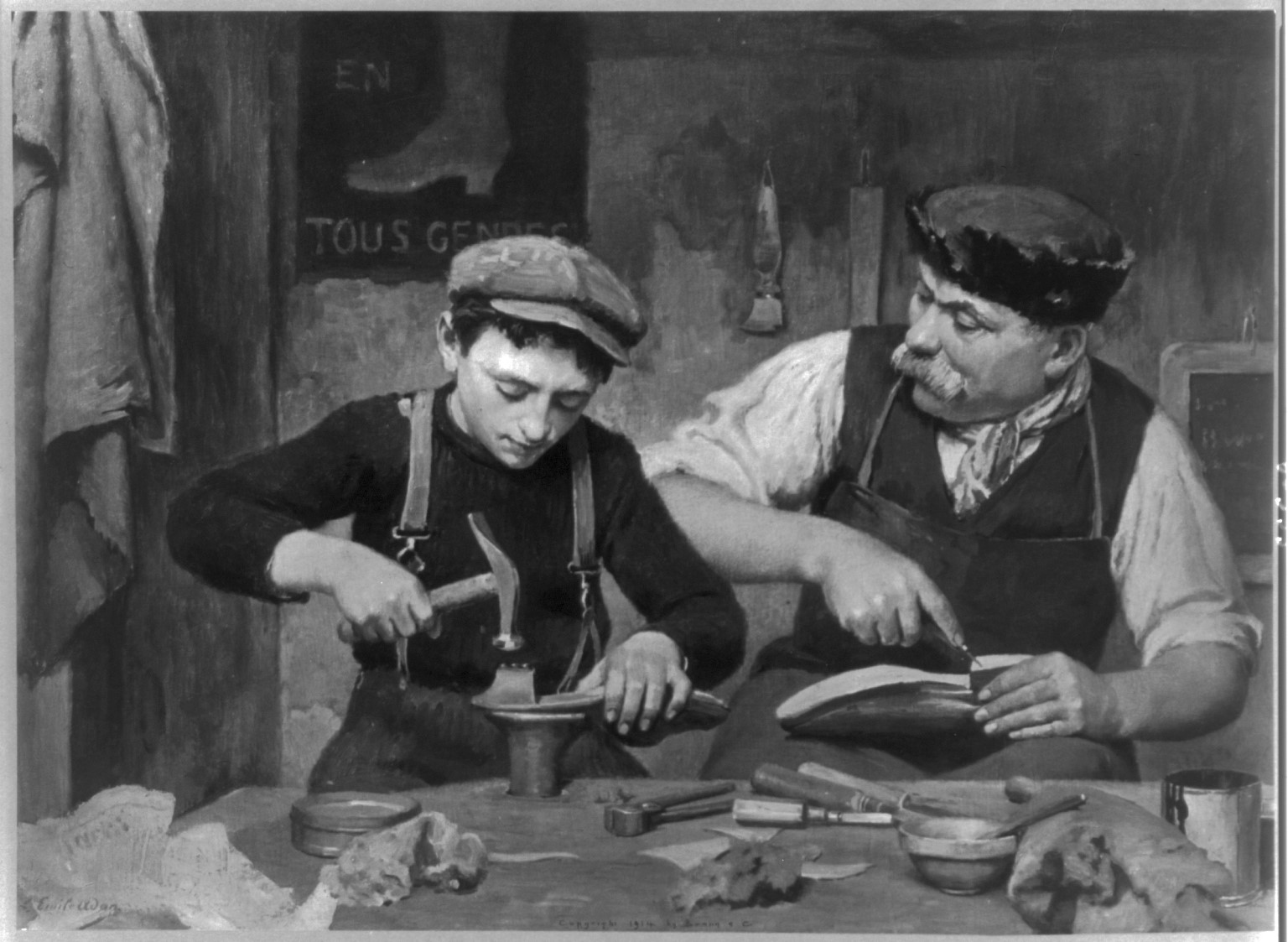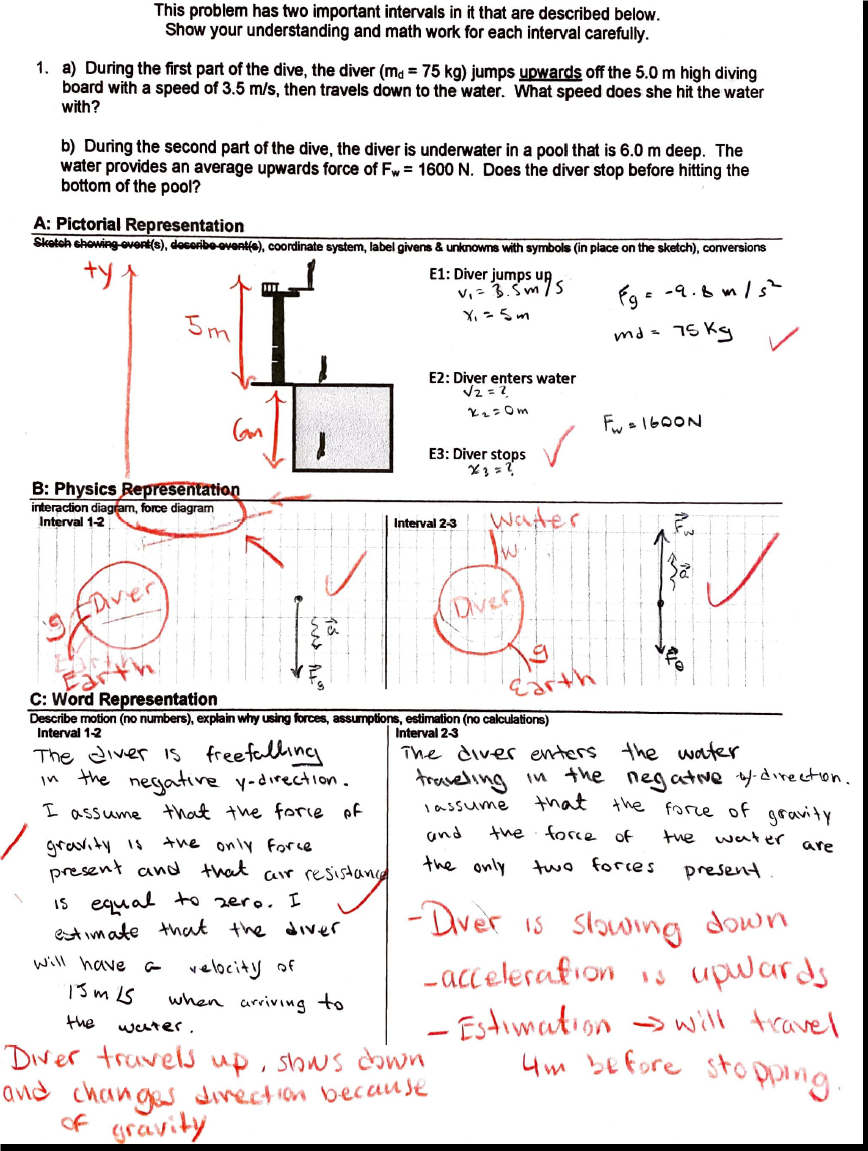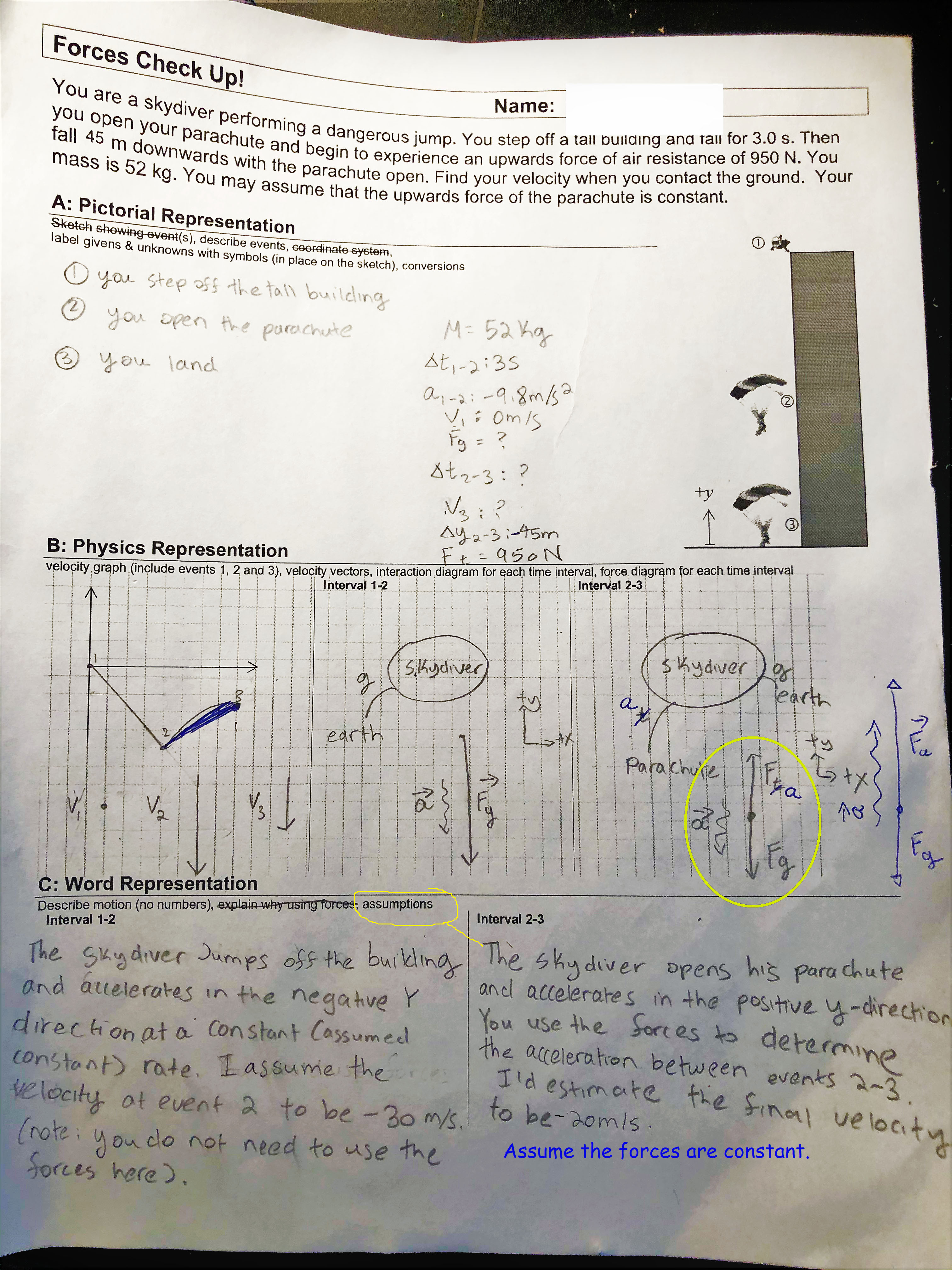Chris Meyer, President, Ontario Association of Physics Teachers
chris_meyer1@sympatico.ca
Enter the Workshop
Let's help our students improve their problem-solving abilities by borrowing an educational idea from long ago. There was a time when learning a complex skill or craft involved years of work as an apprentice in the workshop of an expert. Imagine that we are a young apprentice learning the craft of making shoes:


Our first tasks might be very simple: putting the last tacks in a sole; lacing up the shoe; or adding the final polish. As our skills develop, we are given more complex and challenging tasks and construct more of the shoe until eventually we make our own from start to finish. There are two features of this mode of learning that are useful to emulate in our physics classes: the tasks given to the apprentice are usually meaningful because they help the expert and are important to the success of the workshop as an enterprise; and the apprentice receives rich continuous feedback that is mostly self-generated because she is able to compare her work against that of more experienced people.
Apprenticing the Invisible
In our physics classrooms, or perhaps as we should think of them, our physics workshops, students work on products that are often intangible; we are teaching them conceptual understanding and techniques to untangle and solve complex problems. Much of what is done and created in this workshop exists only in the mind, so we need to give our students a cognitive apprenticeship. This is challenging to do because the skills we share are complex and often operate invisibly in the mind of the expert. To give a cognitive apprenticeship, the teacher needs to do three things: provide meaningful tasks that graduate in difficulty, make their own expert-like thinking processes visible so students can practice them, and provide numerous opportunities for the apprentice to compare their work against that of the expert while engaging in self-reflection.
Tasks That Are Worth Doing
Meaningful tasks in physics involve scientific inquiry or problem solving, and the latter will be the focus of this article. A good way to decide whether a problem-solving task is meaningful is to ask oneself “would anybody outside of school pose a problem like this?” Many problems designed for novices are contrived: why would any reasonable person know these particular pieces of information and not these others; or why would they ever care about this situation? A meaningful task has a reason for its existence that provides an important intrinsic motivation for the apprentice. Physics teachers need to simulate this meaning because the products of our students will not actually be used by the expert or sold by the workshop, alas!
Make the Invisible Visible
To give our students a cognitive apprenticeship, we must make our thinking processes visible, so students are able to observe and practice the many subtle skills involved in problem solving. We can do this using a highly structured problem-solving process that goes beyond just showing mathematical steps (like GRASP/GRASS) and includes representations of the conceptual thinking that guides the expert. If we don't, we are simply hoping students pick up on our thinking habits and practices as they go along; this haphazard approach can only modestly count as education. If we want students to learn efficiently and reliably, make it explicit, provide practice and opportunities for feedback.
Efficient Learning Means Always Assessing
The final element we need to include in our physics apprenticeship is opportunities for assessment and feedback. The teacher will always be the final judge of the quality of any product from the workshop, but the more the apprentice does this, the more they develop the metacognitive skills that help them monitor and improve the quality of their own work and thinking. For basic skills such as drawing force diagrams or writing an expression for the second law of motion, we use rubrics (Meyer, 2019 http://newsletter.oapt.ca/files/why-dont-students-improve-I.html) Our students use their rubrics as a guide and a check for their work involving basic skills. Problem solving is much more complex and so a different strategy is needed.
The problem-solving apprenticeship
The problem-solving process used at my school is highly structured both conceptually, highlighting the physics concepts used, and physically on the page, so each element of the solution is laid out on paper in a precise location. Since the solutions are so highly organized, students can usefully compare each element of their work against the teacher’s solution. This leads to the apprenticeship process my school uses for physics problem solving, which we found worked very well online last spring (2020) during the school shut down. The process follows these steps:
- Solve the problem. Students complete their solution writing in pencil on our standard solution page. Because of the remote learning format, some students chose to write their solution on a PDF that we provided.
- Submit the solution. Students upload their solution to our Google Classroom site. The teacher checks the work mostly for completion; occasionally a student submits something that is way off track, in which case the student is asked to make another attempt.
- Compare and make improvements. The teacher posts the official solution online. Students compare their work to the solution and add corrections or improvements to their page using a different colour. We asked them to make sure that their original work is still clearly visible. In the example below, you can see the student’s original work in black pencil and improvements in red.

- A second submission. Now students submit their improved work. We provide feedback on the improved work, mostly in the form of circling or highlighting elements that are missing or still need to be improved. We do not spend much time writing detailed feedback because the students have already seen the solution and should just refer to it again! In the image below, the student missed making corrections to the second force diagram, so I circled it and sent it back to be improved. The student’s first and second round of corrections are in blue.

- Repeat until excellent. We return the work to the student. If there were no significant concerns, the student is done. However, most students had elements in their solution that were circled and needed to be addressed. Now they must make further corrections or improvements until their work meets our high standard. On occasions, and depending on the significance of the work, there might be a few cycles back and forth between the teacher and the student. This was easy to manage using Google Classroom.
I have used a process like this for the correction to unit tests, but not for the regular homework problems; this process was new as part of our attempt at remote learning. I was very happy with how this worked and will continue to use it in the foreseeable future. The students were able to develop excellent problem-solving skills for the topics of forces and energy even though these were learned entirely online. In fact, I think my students developed a higher level of skill than they do in my regular classes.
The Person Making the Corrections is the One Who is Learning
Let's think about this process to understand why it works and why it is an improvement from what my students have been doing before. In this process, it is the student who invests the time and energy in understanding how their work compares against the work of the teacher. In the past this would have happened in two ways: I would have written the descriptive feedback, or they would have compared their work against other student work on whiteboards. Providing detailed feedback is time consuming for the teacher and student work on whiteboards is often good but not ideal. I do spend more time tracking student work and hassling students to complete their improvements, but much less on descriptive feedback. This process is better.
A Window into the Student Mind
After students submit their improved work, I'm able to see two things: the quality of their original work, and which differences between their work and mine students recognize as significant. This can be very insightful since it provides a window into how students interpret different elements of the solution. Often, they choose trivial details for correction and miss important ones entirely; it is surprising, hilarious and eye-opening.
Feedback is best when it has an immediate purpose
Most students ignore the feedback teachers give on their work. One reason for this is the lack of opportunity to use it right away. Another is that the mark for the piece of work has already been settled. In this process, students do not receive a mark for the solution until the required cycles of improvement are complete. Now they are motivated to look at the simple feedback (the elements that are circled) and make use of it. The process continues until there are no more significant improvements to be made. This is always a judgment call; depending on the problem or the stage in their learning I will be more or less picky. In all cases, the standard for completing the cycles of improvement is very high and might correspond to a 90% or 95% with traditional marking. However, due to the exacting nature of this process I do not need to spend time discerning fine gradations in marks; it's 100% if you complete the cycles of improvement and it's 0% until you do. This strategy is both simple and effective. My time and energy is focused on looking for improvements or helping students directly rather than on lengthy feedback and marking minutiae.
Students can produce excellent work if you require it
The work done in many solutions requires little inspiration or strokes of insight; almost all of it is the careful and accurate execution of well-practised skills. This means almost all students can produce excellent quality work – if you insist on it! If you let them get away with sloppy or sub-par work at any point in their learning process, you are undermining your teaching goals. All work should be done thoughtfully and carefully; we teach students to do this through frequent reflection and comparing with high-quality examples. Don’t wait until the final lessons of a unit or practice for a test to begin applying your exacting standards – that should start on day one. In our shoe workshop, shoddy work would be spotted quickly and rejected; it would not be given a 55% and then ignored. After all, we are providing the apprentice with training (and room and board!) in exchange for useful work. That’s the deal! This is a mastery learning approach: we are training students to become masters, not just to pass.
A quick version of the process
There are times when we want to speed up this process. To do so, we post the solution at the same time the problem is assigned. Most students understand the value of the process and make a reasonable attempt that is not a direct copy of the solution. Spotting the copiers is quite easy and they can be spoken to. From an educational perspective, how grievous is this? When you think about it, the errant student has simply written down their teacher’s solution just as they would have done during a traditional teacher-led lesson and then skipped their homework. These students are no worse off than before but can be cajoled to do better.
A Clear Improvement
In many respects, this apprenticeship process is a clear improvement over what I have done before, working well in my grade 9 science and senior physics classes. Alternate approaches like working with whiteboards in class and sharing solutions are much more collaborative and often lead to good discussions but didn’t lead to work of this quality. I found this process worked really well for our spring online classes when I applied it to all their daily work; currently in the quadmester format, I can only apply this process to a fraction of the work students generate. The “mastery marks” for daily work and problems are assigned under the thinking and communication mark categories, making up roughly 20% of the overall course mark. The course average ends up a little bit higher, but this fairly reflects the improved quality of work. The process is not perfect, and the quick version does allow for some copying. It is time consuming with a lot of student work to track and students to hassle for improvements, but that effort on my part pays off with average student work I can be proud of.
Learn More!
The idea of cognitive apprenticeship was developed in this very interesting paper that I recommend every educator read:
Cognitive apprenticeship is an important component of the ISLE pedagogy developed in part by E. Etkina:
- Etkina, E., Brookes, D. T., & Planinsic, G. (2019). Investigative science learning environment. Morgan & Claypool Publishers. http://www.islephysics.net/resources.php
- Etkina, E., Mestre, J., & O’Donnell, A. (2005). The impact of the cognitive revolution on science learning and teaching. The cognitive revolution in educational psychology, 119-164.
In this article, I describe our improvement process for tests:
Tags: Pedagogy, Remote Learning




